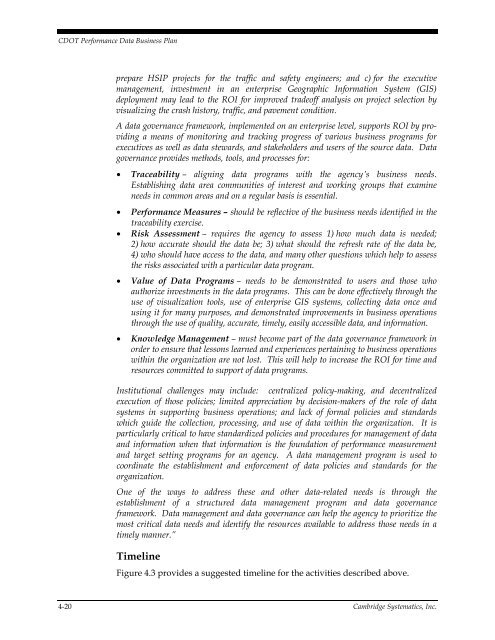CDOT Performance Data Business Plan - Cambridge Systematics
CDOT Performance Data Business Plan - Cambridge Systematics
CDOT Performance Data Business Plan - Cambridge Systematics
Create successful ePaper yourself
Turn your PDF publications into a flip-book with our unique Google optimized e-Paper software.
<strong>CDOT</strong> <strong>Performance</strong> <strong>Data</strong> <strong>Business</strong> <strong>Plan</strong><br />
prepare HSIP projects for the traffic and safety engineers; and c) for the executive<br />
management, investment in an enterprise Geographic Information System (GIS)<br />
deployment may lead to the ROI for improved tradeoff analysis on project selection by<br />
visualizing the crash history, traffic, and pavement condition.<br />
A data governance framework, implemented on an enterprise level, supports ROI by providing<br />
a means of monitoring and tracking progress of various business programs for<br />
executives as well as data stewards, and stakeholders and users of the source data. <strong>Data</strong><br />
governance provides methods, tools, and processes for:<br />
<br />
<br />
<br />
<br />
<br />
Traceability – aligning data programs with the agency’s business needs.<br />
Establishing data area communities of interest and working groups that examine<br />
needs in common areas and on a regular basis is essential.<br />
<strong>Performance</strong> Measures – should be reflective of the business needs identified in the<br />
traceability exercise.<br />
Risk Assessment – requires the agency to assess 1) how much data is needed;<br />
2) how accurate should the data be; 3) what should the refresh rate of the data be,<br />
4) who should have access to the data, and many other questions which help to assess<br />
the risks associated with a particular data program.<br />
Value of <strong>Data</strong> Programs – needs to be demonstrated to users and those who<br />
authorize investments in the data programs. This can be done effectively through the<br />
use of visualization tools, use of enterprise GIS systems, collecting data once and<br />
using it for many purposes, and demonstrated improvements in business operations<br />
through the use of quality, accurate, timely, easily accessible data, and information.<br />
Knowledge Management – must become part of the data governance framework in<br />
order to ensure that lessons learned and experiences pertaining to business operations<br />
within the organization are not lost. This will help to increase the ROI for time and<br />
resources committed to support of data programs.<br />
Institutional challenges may include: centralized policy-making, and decentralized<br />
execution of those policies; limited appreciation by decision-makers of the role of data<br />
systems in supporting business operations; and lack of formal policies and standards<br />
which guide the collection, processing, and use of data within the organization. It is<br />
particularly critical to have standardized policies and procedures for management of data<br />
and information when that information is the foundation of performance measurement<br />
and target setting programs for an agency. A data management program is used to<br />
coordinate the establishment and enforcement of data policies and standards for the<br />
organization.<br />
One of the ways to address these and other data-related needs is through the<br />
establishment of a structured data management program and data governance<br />
framework. <strong>Data</strong> management and data governance can help the agency to prioritize the<br />
most critical data needs and identify the resources available to address those needs in a<br />
timely manner.”<br />
Timeline<br />
Figure 4.3 provides a suggested timeline for the activities described above.<br />
4-20 <strong>Cambridge</strong> <strong>Systematics</strong>, Inc.

















